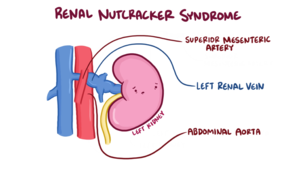This time of year, when you hear the term “nutcracker,” the seasonal ballet or holiday decoration might come to mind. However, for those suffering with Nutcracker Syndrome, the term brings to mind a painful condition that can affect their ability to function and their quality of life on a daily basis.
If you are diagnosed with Nutcracker Syndrome today, the good news is there are effective ways to diagnose and treat the disorder, as well as the painful symptoms that often accompany it.
Why does Nutcracker Syndrome occur?
Nutcracker syndrome is a relatively rare condition that occurs when the vein running from the left kidney becomes compressed between the abdominal aorta and the superior mesenteric artery. The renal vein assimilates a nut in a nutcracker – caught between two stronger objects. This is where the condition got its name.
The condition can occur in both adults and children and is most common in tall, slender women in their 30s and 40s. It is also more likely to occur after weight loss or pregnancy. However, the actual cause of Nutcracker Syndrome is unknown at this point.
Symptoms of Nutcracker Syndrome
Nutcracker Syndrome can present with painful and sometimes distressing symptoms, including:
- Abdominal pain and pain around the flank area
- Blood in the urine
Women may experience additional symptoms, such as:
- Heaviness around the pelvic area
- Painful intercourse
- The formation of varicose veins in the lower abdomen
- Menstruation that is more painful than usual
Diagnosis of Nutcracker Syndrome
Despite the fact that Nutcracker Syndrome is generally accompanied by some fairly noticeable symptoms, it can be difficult to diagnose. If you have any or all of these symptoms, it is important to see a physician that specializes in vein disorders in order to get an accurate diagnosis and treatment as quickly as possible. These doctors have the equipment, knowledge, and experience to provide you with a correct diagnosis and some will also offer effective treatment options for the condition that eradicate both the compression and the painful symptoms.
Treatment Options
In some cases, no treatment may be needed for Nutcracker Syndrome, since the blood may naturally reroute to more open vessels. However, when the condition does not resolve on its own, stenting can be used to open up the renal vein and eliminate the discomfort. A stent is a small tube that is placed inside the vein to work against the compression and keep the vein open for better blood flow.
Stenting is a procedure performed by a vein specialist, usually on an outpatient basis. A catheter is inserted into a vein in the groin and threaded into the vessel requiring treatment. The catheter opens up the vessel so that the stent may be placed. The entire procedure is relatively comfortable for the patient and most go home a few hours afterward.
When you require venous stenting of any kind, it is important to choose a physician that is experienced in this procedure. Dr. Draughn at Vein Specialists of the Carolinas performs vein stenting to treat different conditions, including Nutcracker Syndrome. He will be able to diagnose and treat your condition in his state-of-the-art vascular lab, eliminating the vein disorder and painful symptoms.
To learn more, contact Vein Specialists of the Carolinas today at 704-861-2072 or 704-544-5245.
“All We Do Is Veins, All Day Every Day.”

